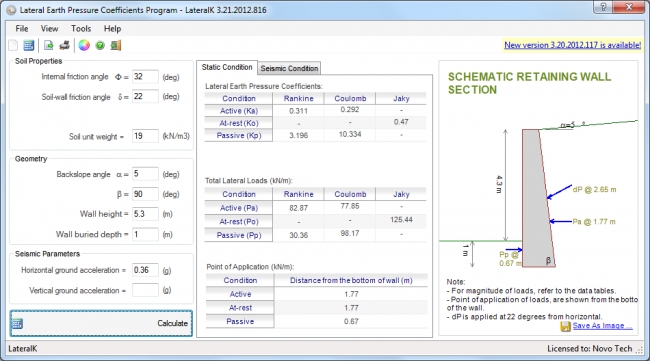Earth Pressures Software
The theoretical concepts used in the PYWALL software extendbeyond the conventional method of analysis and design of flexibleretaining walls based on limit-equilibrium theory. As a difference toconventional pratice, the PYWALL method includes the effects ofsoil-structure interaction.Modern methods of analyses of the behavior of retaining structuresconsider realistic soil conditions and relevant details of thestructural system. Therefore, a rational method of analysis and designmust include the nonlinear soil-resistance-displacement relationships,pile spacings, penetration depths and structural properties. PYWALLconsiders soil-structure interaction by using a beam-column model andcan analyze the behavior of a flexible retaining wall or soldier-pilewall with or without tiebacks or bracing systems.Optionally, users may calculate externally and input anytype of earth-pressure distributions. The program caninterpolate linearly between inputted values of pressureplaced at different depths.Specify deflections or slopes at any point in the heightof the wall. This input option allows designers to makea better simulation of braces having limited movementsor to model specific conections between braces andwall.Flexural stiffness of the wall may be varied and/orlinearly interpolated at different wall heights.Soil-resistance ( p-y) curves can be internallygenerated by the program for the following 7 types ofsoils: soft clay, stiff clay with or without free water,sand, silt (c-phi soil), weak rock androck. Internally-generated p-y curves may be printed forreviews or reference.Users may optionally input their own soil-resistance( p-y) curves at any desired depth.
Geo 5 Online


PYWALL usesdouble-precision algorithms to reach better solutions inthe nonlinear iterations.User-defined multipliers can be specified to increase orreduce the soil resistance ( p-y curves) at anydepth of the wall below the dredge line. For instance,this feature may be used in seismic conditions to reducethe response of liquefied layers, or to consider creepeffects for long-term conditions or for closely-spacedpiles.The program provides users with standard cross-sectiondata base for H-piles and Sheet-piles, and as well asuser-specified cross sections.Ensoft Inc, 2019.

Passive Lateral Earth Pressures in Retaining WallsPassive pressures what is it and why?When we excavate on one side of a retaining wall an unbalanced load condition is created. As it is very obvious, the retained side wants to move into the recently excavated zone.
However, we engineers boldly introduce our retaining walls in the middle to take care of the unbalance.